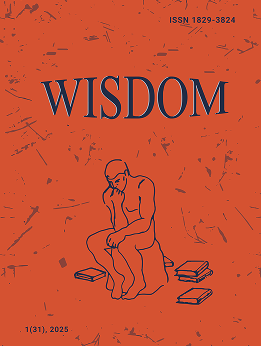The Phenomenology of the “Sitting Inside”: A Socio-Philosophical Analysis
DOI:
https://doi.org/10.24234/wisdom.v23i3.793Keywords:
personality, multiple subjectivity, within, multiple personalities, pathological deformityAbstract
The article deals with the problem of transforming human subjectivity. Factors which condition the formation of the internal concept of the Self, as a phenomenon “sitting inside,” are defined. Aspects connected with the concept of “norm” and “pathology” from positions of modern philosophy, social psychology, psychoanalysis and medicine are analyzed. The relevance of the study: at present, there is a radical revision of ideas about the inner component of the self-concept.
The aim of the study is to explore the socio-philosophical aspects of multiple subjectivities of the individual from the perspective of the phenomenon of “sitting inside”.
In addition to the general scientific methods of analysis and synthesis, the research methodology involves the application of methods such as the systematic method, the method of interdisciplinary research and the method of hypothetical modelling.
The author’s interpretation of the phenomenon of “multiple subjectivities” is given. The results of the study have been the subject of numerous discourses at scientific and practical conferences at international and all-Russian levels and seminars.
The study concludes that the phenomenon of “sitting inside” should be characterized as a pathological deformation of personality subjectivity.
Downloads
References
Deleuze, J. (1998). Razlichie i povtorenie (Dif-ference and repetition, in Russian). (N. B. Mankovskaya, & E. P. Yurovskaya, Trans.). Saint Peters-burg: Petropolis.
Goncharenko, N. (1991). Genij v iskusstve i nauke (Genius in art and science, in Russian). Moscow: Art.
Hegel, H. W. F. (2008). Sistema nauk. Ch. 1. Fenomenologiya dukha (System of the sciences. Part. 1. Phenomenology of spirit, in Russian) (G. Shpet, Trans.). Moscow: Acad. Project.
Hillman, J. (1996). Arhetipicheskaya psi-hologiya (Archetypal psychology, in Russian). (Y. Donets, & V. Zelensky, Trans.). Saint Petersburg: B.S.K.
Hofstadter, D. (2003). Glaz razuma (The mind’s eye, in Russian). (M. Eskina, Trans.). Samara: Bahran-M Publish-ing House.
Jung, K. (1994). Basic postulates of analytical psychology. Princeton: Princeton University Press.
Keys, D. (2015). Tainstvennaya istoriya Billi Milligana (The mysterious story of Billy Milligan, in Russian). (Y. Fedo-rova, Trans). Moscow: Eksmo.
Knyazeva, E., & Kurdyumov, S. (2011). Osnovaniya sinergetiki: chelovek, konstruiruyushchij sebya i svoe budush-chee (Foundations of synergetic: Man constructing himself and his future, in Russian). (4th ed.). Russian Academy of Sciences, Institute of Philosophy. Moscow: URSS: LIBROCOM.
Lang, R. D. (2017). Raskolotoe “Ya”: ekzis-tencial'noe issledovanie “normal'nosti” i “bezumiya”; Fenome-nologiya perezhivaniya i Rajskaya ptichka (The split ‘self’: An existential study of ‘normality’ and ‘mad-ness’; The phenomenology of experience and the bird of paradise, in Russian). Moscow: IOI.
Levin, K. (2000). Teoriya polya v social'nykh naukah (Feld theory in the social sciences, in Russian). Saint Petersburg: Rech.
Lotman, Y. M. (1992). Izbrannye stat'i v 3-kh tomakh. T.1. O dvukh modelyakh kommunikacii v sisteme kul'tury (Selected articles in 3 volumes. Vol. 1. On the two models of communication in the system of culture, in Russian). Tallinn: Aleksandra.
Mukhina, V. S. (2010). Otchuzhdennye: Ab-solyut otchuzhdeniya (Alienated: The absolute of alienation, in Russian). (2nd ed.). Holy Trinity Sergius Lavra.
Pshizov, V. S. (2015). Psikhicheskaya norma i patologiya: zhizn’ “man’yaka”, pogoda i sumasshestvie, sud’ba moshennika-simulyanta, prestuplenie protiv chelovechnosti (Mental norm and pathology: The life of a “maniac”, weather and madness, the fate of a fraudulent simulator, a crime against humanity, in Russian). Saint Peters-burg: Nestor-Istoriya.
Roberts, J. (1992). The logic of reflection: German philosophy in the twentieth century. New Haven; London: Yale University Press.
Rozin, V. M. (2009). Fenomen mnozhestvennoj lichnosti: po materialam knigi Deniela Kiza “Mnozhestvennye umy Billi Milligana” (The phenomenon of multiple personality: On the materials of Daniel Keyes’ book “The multiple minds of Billy Milligan”, in Russian). Moscow: LIBROCOM.
Schreiber, F.-R. (2013). Sivilla: roman (Sivil-la: Novel, in Russian). Saint Peters-burg: Azbuka
Sheldon, S. (2015). Raskolotye sny: roman (Shattered dreams: Novel, in Rus-sian). (T. Pertseva, Trans.). Moscow: AST
Tetenkov, N. (2017). S. K’erkegor: dvizhenie k mnozhestvennoj sub”ektivnosti (S. Kierkegaard (2017). Moving towards multiple subjectivity, in Russian). Vestnik Severnogo (Arkticheskogo) federal’nogo universiteta. Ser. Humanities and Social Sciences, 1, 71-77.
Thigpen, C. H. (1958). The three faces of eve. The American Journal of Psychology, 71(2), 488. Published By: University of Illinois Press
Toynbee, A. D. (2012). Issledovanie istorii: vozniknovenie, rost i raspad civili-zacij (Exploring history: Emergence, growth and decay of civilizations, in Russian). (K. Kozhurin, Trans). Mos-cow: AST: Astril.
Downloads
Published
Versions
- 2022-09-27 (2)
- 2022-09-25 (1)
How to Cite
Issue
Section
License
Copyright (c) 2022 Nikolay TETENKOV

This work is licensed under a Creative Commons Attribution-NonCommercial 4.0 International License.
Creative Commons Attribution-Non-Commercial (CC BY-NC). CC BY-NC allows users to copy and distribute the article, provided this is not done for commercial purposes. The users may adapt – remix, transform, and build upon the material giving appropriate credit, and providing a link to the license. The full details of the license are available at https://creativecommons.org/licenses/by-nc/4.0/.















